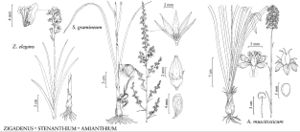Difference between revisions of "Zigadenus elegans"
Fl. Amer. Sept. 1: 241. 1814.
FNA>Volume Importer |
FNA>Volume Importer |
||
| Line 84: | Line 84: | ||
|elevation=0–3600 m | |elevation=0–3600 m | ||
|distribution=Alta.;B.C.;Man.;N.W.T.;Ont.;Que.;Sask.;Yukon;Alaska;Ariz.;Colo.;Idaho;Ill.;Ind.;Iowa;Md.;Mich.;Minn.;Mo.;Mont.;Nebr.;Nev.;N.Mex.;N.Y.;N.C.;N.Dak.;Ohio;Oreg.;Pa.;S.Dak.;Tenn.;Tex.;Utah;Vt.;Va.;Wash.;W.Va.;Wis.;Wyo.;Mexico. | |distribution=Alta.;B.C.;Man.;N.W.T.;Ont.;Que.;Sask.;Yukon;Alaska;Ariz.;Colo.;Idaho;Ill.;Ind.;Iowa;Md.;Mich.;Minn.;Mo.;Mont.;Nebr.;Nev.;N.Mex.;N.Y.;N.C.;N.Dak.;Ohio;Oreg.;Pa.;S.Dak.;Tenn.;Tex.;Utah;Vt.;Va.;Wash.;W.Va.;Wis.;Wyo.;Mexico. | ||
| − | |discussion=<p><i>Zigadenus elegans</i> has been treated previously as comprising two varieties, or two subspecies (W. B. Zomlefer 1997b). The western var. or <i></i>subsp.<i> elegans</i> tends to be a smaller plant with a raceme or a 1–2-branched panicle and glabrous, sometimes glaucous leaves and stems; while the eastern var. or <i></i>subsp.<i> glaucus</i> tends to be a larger plant with a paniculate inflorescence and glaucous leaves and stems. Because there is considerable evidence of intergradation between the two entities toward the middle of the range, including overlapping flowering times, they have not been formally distinguished here.</p> | + | |discussion=<p><i>Zigadenus elegans</i> has been treated previously as comprising two varieties, or two subspecies (W. B. Zomlefer 1997b). The western var. or <i></i></i>subsp.<i><i> elegans</i> tends to be a smaller plant with a raceme or a 1–2-branched panicle and glabrous, sometimes glaucous leaves and stems; while the eastern var. or <i></i></i>subsp.<i><i> glaucus</i> tends to be a larger plant with a paniculate inflorescence and glaucous leaves and stems. Because there is considerable evidence of intergradation between the two entities toward the middle of the range, including overlapping flowering times, they have not been formally distinguished here.</p> |
|tables= | |tables= | ||
|references= | |references= | ||
| Line 108: | Line 108: | ||
|publication year=1814 | |publication year=1814 | ||
|special status= | |special status= | ||
| − | |source xml=https://jpend@bitbucket.org/aafc-mbb/fna-data-curation.git/src/ | + | |source xml=https://jpend@bitbucket.org/aafc-mbb/fna-data-curation.git/src/f6b125a955440c0872999024f038d74684f65921/coarse_grained_fna_xml/V26/V26_86.xml |
|genus=Zigadenus | |genus=Zigadenus | ||
|species=Zigadenus elegans | |species=Zigadenus elegans | ||
Revision as of 19:34, 24 September 2019
Plants 2–8 dm, from bulbs; bulbs not clumped, tunicate, narrowly ovoid, 1.5–3 × 1–2 cm. Stems without persistent leaf bases. Leaves: proximal blades 10–30 cm × 3–15 mm. Inflorescences loosely racemose to paniculate, 10–50-flowered, with 1–4 branches, 0.9–2.5 dm × 3–6 cm. Flowers: perianth perigynous, rotate to rotate-campanulate, 15–20 mm diam.; tepals persistent in fruit, cream colored to greenish, ovate, 7–12 × 4–5 mm, somewhat narrowed at base; gland 1, obcordate; pedicel erect at anthesis, 1–2.3 cm, bracts often tinged with purple or pink, ovate, 5–20 mm. Capsules narrowly conic, 10–20 mm. 2n = 32.
Phenology: Flowering Jun–Aug.
Habitat: Moist grasslands, river and lake shores, bogs in coniferous forests
Elevation: 0–3600 m
Distribution

Alta., B.C., Man., N.W.T., Ont., Que., Sask., Yukon, Alaska, Ariz., Colo., Idaho, Ill., Ind., Iowa, Md., Mich., Minn., Mo., Mont., Nebr., Nev., N.Mex., N.Y., N.C., N.Dak., Ohio, Oreg., Pa., S.Dak., Tenn., Tex., Utah, Vt., Va., Wash., W.Va., Wis., Wyo., Mexico.
Discussion
Zigadenus elegans has been treated previously as comprising two varieties, or two subspecies (W. B. Zomlefer 1997b). The western var. or subsp. elegans tends to be a smaller plant with a raceme or a 1–2-branched panicle and glabrous, sometimes glaucous leaves and stems; while the eastern var. or subsp. glaucus tends to be a larger plant with a paniculate inflorescence and glaucous leaves and stems. Because there is considerable evidence of intergradation between the two entities toward the middle of the range, including overlapping flowering times, they have not been formally distinguished here.
Selected References
None.
